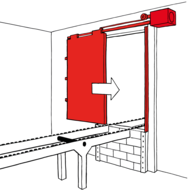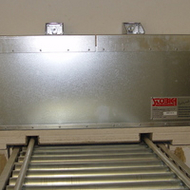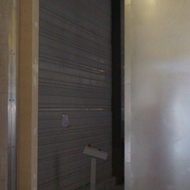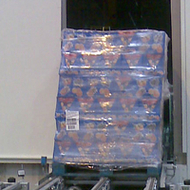
[DE] - Produktbeschreibung
La compuerta deslizante de paneles de chapa se caracteriza por su robusta estructura de sándwich con cubierta de chapa por todos los lados. Se presta para el uso en sistemas de transporte continuo y discontinuo, como transportadores de correas, rodillos y cadenas de carga. Los elementos deslizantes segmentados permiten un transporte sin problemas hasta el lugar de instalación. Las áreas fijas variables permiten implementar fácilmente soluciones personalizadas.

Típo de construcción | [DE] - Feuerschutzabschluss im Zuge bahngebundener Förderanlagen |
[DE] - Verwendbarkeitsnachweis | [DE] - European Technical Assessment - ETA |
Sentido de cierre | [DE] - von links nach rechts • de la derecha a la izquierda • desde arriba hacia abajo |
[DE] - Feuerwiderstand | [DE] - EI1 120 |
ciclos de cierre | [DE] - C5 Anzahl der Schließzyklen 200.000 |
reapertura | [DE] - motorisch (Standard) • manual |
Transportador | [DE] - Skid-Förderer • [DE] - Gefällebahn • transportador interrumpido • [DE] - Durchgehende Gurtfördertechnik • [DE] - Durchgehender Verfahrwagen • [DE] - Durchgehende Tragkettenfördertechnik • transportador de rodillos continuos • [DE] - Durchgehende Fördertechnik |
Calidad de pared requerida | |
|---|---|
Hormigón | d = 200 mm |
Mampostería | d = 200 mm |
Hormigón celular | d = 200 mm |
Tabiques de montaje | d = 160 mm |
Estructura de planchas de acero según | DIN 4102-4 |
Rango de homologación (13,5 m² dirección de cierre horizontal) | |
|---|---|
LB | hasta 4500 mm |
LH | hasta 4500 mm |
Viabilidad técnica | |
|---|---|
LB | hasta 4500 mm |
LH | hasta 5100 mm |
Calidad de pared requerida | |
|---|---|
Hormigón | d = 200 mm |
Mampostería | d = 200 mm |
Hormigón celular | d = 200 mm |
Tabiques de montaje | d = 160 mm |
Estructura de planchas de acero según | DIN 4102-4 |
Rango de homologación (12,1 m² dirección de cierre vertical) | |
|---|---|
LB | hasta 4500 mm |
LH | hasta 4500 mm |
Viabilidad técnica (máx. 20,25 m²) | |
|---|---|
LB | hasta 4500 mm |
LH | hasta 5100 mm |






![[DE] - Systemzeichnungen - Horizontal [DE] - Systemzeichnungen - Horizontal](/typo3temp/assets/_processed_/b/2/csm_stoebich_db_5c053fae91e01_0_c0a2063119.jpg)
![[DE] - Systemzeichnungen - Vertical [DE] - Systemzeichnungen - Vertical](/typo3temp/assets/_processed_/4/d/csm_stoebich_db_5c051e483b872_0_de9545b668.jpg)